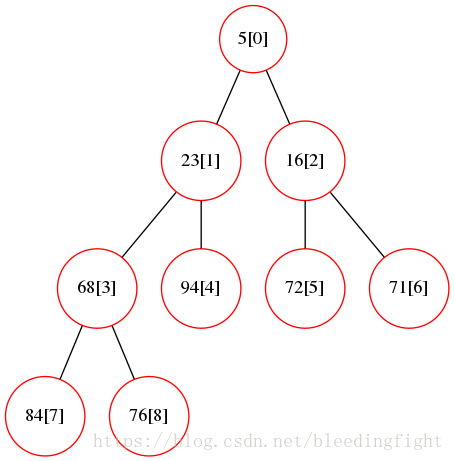堆排序算法
- 构建最小堆
- 取出最小堆第一个元素(最小值)
- 剩下的数据构造最小堆(反复执行2,3直到取出所有的值为止)
数组[72,23,5,68,94,16,71,84,76]表示的树构造最小堆:

最小堆的元素有如下关系:
- 节点k的左右节点为2*k+1,2*k+2 ,你如节点5(index=2)左边节点71(index=2*2+1),右边节点84(index=2*2+1)
尽管这个图满足乐这个关系,但是不满足另一个关系(这个图不是最小堆):
- 节点的字节点都比节点大。
构造生成的最小堆:

如何通过节点k获取父节点信息?
k/2 就是父节点索引(如果除不尽则舍去小数点,代码中因为是整数除,所以不用管。)
非叶子节点的个数length(array)/2-1
构造最小堆,从根节点开始,如果根节点的左子节点小于根节点,就找根节点孩子节点中更小的值,找到后将值和根节点的值交换,然后沿着下一个节点继续查找(查找不需要找叶子节点,因为叶子节点没有孩子,所以只需要查找length(array)/2-1)个节点。这里发现孩子节点中5最小于是交换5和根节点的位置。对于右节点72 的字节点71,84 ,因为左节点71小于该节点72,于是交换72 节点和他的孩子中的最小值16 交换。完成最小堆的构建。
性能分析
对于最小堆(节点数n,根节点为0层,树的高度为h):
- 第i层节点数最多为
n+12h−i
n
+
1
2
h
−
i
,以上面的例子来看:树的最大节点数n为15(将64,72,71 的叶子补齐)。高度h为4。最后一层的元素个数为(n+1)/2^{4-3}=8,导数第二层(n+1)/2^{4-2}=4
- 第i层所做操作最多为第i 层节点数乘上交换次数。比如例子中最后一层无需做任何交换,但是倒数第二层最多每个节点做一次交换,倒数第三层可能除了和倒数第二层交换后,交换到倒数第二层的元素可能还需要和倒数第一层的元素交换,这样需要两次交换。倒数第四层同样的道理需要3次交换。
i 层交换的次数为
2i∗(h−i−1)
2
i
∗
(
h
−
i
−
1
)
,总的交换次数为:
∑h−2i=02i∗(h−i−1)=
∑
i
=
0
h
−
2
2
i
∗
(
h
−
i
−
1
)
=
如果往堆里面插入一个元素需要 log2(n) l o g 2 ( n ) 次比较
n 个元素插入,删除时间
nlog2(n)+nlog2(n)
n
l
o
g
2
(
n
)
+
n
l
o
g
2
(
n
)
为
O(nlog(n))
O
(
n
l
o
g
(
n
)
)
在上面的例子中总交换次数次数 20⋅3+21⋅2+22⋅3 2 0 ⋅ 3 + 2 1 ⋅ 2 + 2 2 ⋅ 3 。
总共时间代价为建堆的时间代价 O(nlog(n)) O ( n l o g ( n ) ) 和交换的时间代价 n n 的总代价为
代码解析
下面的代码中排序只是一个简单的实现,主要是为了展现堆的数据结构和数组实现。
构造函数用一个MaxSize表示当前堆容纳的数组元素的最大数。CurrentSize是当前存放的数据的大小,heapArray存放待排序数据中的所有元素。
#include <iostream>
using namespace std;
class MinHeap{
private:
int *heapArray;
int CurrentSize;
int MaxSize;
void BuildHeap(int n);
public:
MinHeap(const int n,const int *a);//构造函数实现创建一个n个元素的堆,最大容量为n+10
virtual ~MinHeap();//析构函数
bool isLeaf(int pos) const;//是不是叶子节点(在排序中没有用)但是应该作为堆的一部分才更完三
int leftchild(int pos) const;//是不是左孩子,这里这个函数也不是必须,主要是用来确定孩子那个更小,将更小的向上siftup
int parent(int pos) const;//获取当前位置的父节点
bool Remove(int pos,int & node);//删除位置pos的元素给赋值给node
bool Insert(const int &newNode);//插入newnode元素
void RemoveMin(int &min_val);//删除堆的第一个元素(最小值)
void SiftUp(int position);//向上交换
void SiftDown(int position);//向下交换
void show();//方便调试
void sort();
};
MinHeap::MinHeap(const int n,const int *a) {
CurrentSize = n;
MaxSize = CurrentSize+10;
heapArray = new int[MaxSize];
int i=0;
for(int i=0;i<n;i++)
heapArray[i] = a[i];
BuildHeap(CurrentSize);
}
MinHeap::~MinHeap() {
delete [] heapArray;
}
void MinHeap::SiftDown(int position) {
int i = position;
int j = 2*i+1;
int temp = heapArray[i];
while(j<CurrentSize)
{
if(j<CurrentSize-1&&heapArray[j]>heapArray[j+1])
j++;
if(temp>heapArray[j])
{
heapArray[i] = heapArray[j];
i = j;
j = 2*j+1;
}
else
break;
}
heapArray[i] = temp;
}
void MinHeap::BuildHeap(int n) {
CurrentSize = n;
for(int i=CurrentSize/2-1;i>=0;i--)
{
SiftDown(i);
}
}
void MinHeap::SiftUp(int position) {
int temppos = position;
int temp = heapArray[temppos];
while((temppos>0)&&(heapArray[parent(temppos)]>temp))
{
heapArray[temppos] = heapArray[parent(temppos)];
temppos=parent(temppos);
}
heapArray[temppos] = temp;
}
bool MinHeap::Remove(int pos, int &node) {
if((pos<0)||(pos>=CurrentSize))
return false;
int temp = heapArray[pos];
heapArray[pos] = heapArray[--CurrentSize];
if(heapArray[parent(pos)]>heapArray[pos])
SiftUp(pos);
else
SiftDown(pos);
node = temp;
return true;
}
int MinHeap::parent(int pos) const {
return pos/2;
}
void MinHeap::RemoveMin(int &min_val) {
min_val = heapArray[0];
for(int i=1;i<CurrentSize;i++)
heapArray[i-1]=heapArray[i];
}
bool MinHeap::isLeaf(int pos) const {
if(pos*2+1>=CurrentSize)
return true;
else
return false;
}
int MinHeap::leftchild(int pos) const {
if(pos*2+1<CurrentSize)
return pos*2+1;
}
bool MinHeap::Insert(const int &newNode) {
if(CurrentSize == MaxSize)
return false;
heapArray[CurrentSize] = newNode;
SiftUp(CurrentSize);
CurrentSize++;
}
void MinHeap::show() {
for(int i=0;i<CurrentSize;i++)
cout<<heapArray[i]<<" ";
cout<<"n";
}
void MinHeap::sort() {
int min_val;
for(int i=CurrentSize;i>0;i--)
{
BuildHeap(i);
RemoveMin(min_val);
cout<<min_val<<" ";
}
cout<<"n";
}
int main()
{
int a[] = {72,23,5,68,94,16,71,84,76};
MinHeap m = MinHeap(9,a);
m.Insert(63);
m.show();
// m.sort();
}最后
以上就是友好手机最近收集整理的关于堆排序堆排序算法的全部内容,更多相关堆排序堆排序算法内容请搜索靠谱客的其他文章。








发表评论 取消回复